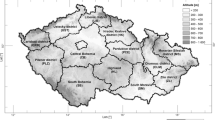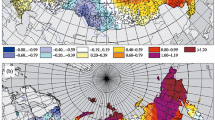Abstract
Some aspects of long-term variability of temperature extremes on the territory of Russia are considered using average daily surface air temperature data from 367 weather stations over the period of 1960-2016. The number of days with extremely high summer temperature has increased monotonously (with strong peaks in some years) in the European part of Russia since the 1980s; in the Asian part of Russia this growth stopped in the early 2000s. The number of cold extremes has decreased. Changes in winter mainly agree with the general warming, but in the Asian part of Russia the warming trend is superimposed by about 40-year oscillations resembling variations in the leading atmospheric circulation modes: the North Atlantic Oscillation (NAO) and the Scandinavian pattern. The statistics of indices of extremes in the opposite phases of the modes revealed a strong response in winter, which explains qualitatively the features of long-term variations in temperature extremes. A difference in composites between the positive and negative NAO phases is mostly negative for cold extremes and positive for warm ones. The response to the Scandinavian mode is opposite. In summer, the response is generally weak, but in the west of the European part of Russia the heat wave duration is strongly linked to variations in the Scandinavian pattern.
Similar content being viewed by others
References
M. Yu. Bardin, “Anticyclonic Quasistationary Circulation and Its Effect on Air Temperature Anomalies and Extremes over Western Russia,” Meteorol. Gidrol., No. 2 (2007) [Russ. Meteorol. Hydrol., No. 2, 32 (2007)].
M. Yu. Bardin, “Scenario Forecasts of Air Temperature Variations for the Regions of the Russian Federation up to 2030 Using the Empirical Stochastic Climate Models,” Meteorol. Gidrol., No. 4 (2011) [Russ. Meteorol. Hydrol., No. 4,36(2011)].
M. Yu. Bardin, O. N. Bulygina, and T. V. Platova, “Extremeness of Climate,” in Second Roshydromet Assessment Report on Climate Change and Its Consequences in Russian Federation (Roshydromet, Moscow, 2014) [in Russian].
M. Yu. Bardin, T. V. Platova, and O. F. Samokhina, “Features of Climate Change Characteristics on the Territory of Northern Eurasia Based on the Routine Climate Monitoring and Possible Factors,” Trudy Gidromettsentra Rossii, No. 358 (2015) [in Russian].
V. V. Vinogradova, “Heat Waves in Russia as a Factor of Nature Environment Discomfort,” Izv. Akad. Nauk, Geografiya, No. 4 (2016) [in Russian].
V. V. Vinogradova, “Winter Cold Waves in Russia since the Second Half of the 20th Century,” Izv. Akad. Nauk, Geografiya, No. 3 (2018) [in Russian].
Second Roshydromet Assessment Report on Climate Change and Its Consequences in Russian Federation. General Summary, Ed. by V. M. Kattsov, S. M. Semenov, M. Yu. Bardin, G. V. Gruza, E. Ya. Ran’kova, et al. (Roshydromet, Moscow, 2014) [in Russian].
G. V. Gruza and E. Ya. Ran’kova, “Estimation of Probable Contribution of Global Warming to the Genesis of Abnormally Hot Summers in the European Part of Russia,” Izv. Akad. Nauk, Fiz. Atmos. Okeana, No. 6, 47 (2011) [Izv., Atmos. Oceanic Phys., No. 6, 47 (2011)].
Report on Climate Features in the Russian Federation in 2016 (Roshydromet, Moscow, 2017) [in Russian].
Climate Change. Review of the State and Trends in Climate Change in Russia (Bulletin) (2018), http://climatechange.igce.ru/index.php?option=com_docman&task=cat_view&gid=32&Itemid=75&lang=ru.
D. B. Kiktev, D. M. H. Sexton, L. V. Alexander, and C. K. Folland, “Trends in Fields of Precipitation and Surface Temperature Annual Extremes during the Second Half of the 20th Century,” Meteorol. Gidrol., No. 11 (2002) [Russ. Meteorol. Hydrol., No. 11 (2002)].
D. E. Knuth, The Art of Computer Programming, Vol. 2: Half-numbered Algorithms (Vil’yams, Moscow, 2000) [Transl. from English]
O. Yu. Kovalenko, M. Yu. Bardin, and E. N. Voskresenskaya, “Changes in Characteristics of Air Temperature Extremes over the Black Sea Region and Their Variability Associated with Interannual Large-scale Climatic Processes,” Fundamental’nay a i Prikladnaya Klimatologiya, No. 2 (2017) [in Russian].
A. M. Obukhov, M. V. Kurganskii, and M. S. Tatarskaya, “Dynamic Conditions of the Origin of Droughts and Other Large-scale Weather Anomalies,” Meteorol. Gidrol., No. 10 (1984) [Sov. Meteorol. Hydrol., No. 10 (1984)].
T. V. Platova, “Climatic Characteristics of Some Indices of Surface Air Temperature and Precipitation Extremes in Russia,” Bulletin “Use and Protection of Natural Resources in Russia,” No. 1 (2007) [in Russian].
V. V. Popova, “Modern Climate Change in Northern Eurasia as a Manifestation of Variations in Large-scale Atmospheric Circulation,” Fundamental’naya i Prikladnaya Klimatologiya, No. 1 (2018) [in Russian].
V. V. Popova and A. B. Shmakin, “Regional Structure of Surface-air Temperature Fluctuations in Northern Eurasia in the Latter Half of the 20th and Early 21st Centuries,” Izv. Akad. Nauk, Fiz. Atmos. Okeana, No. 2, 46 (2010) [Izv., Atmos. Oceanic Phys., No. 2, 46 (2010)].
L. V. Alexander, X. Zhang, T. C. Peterson, J. Caesar, B. Gleason, A. M. G. Klein Tank, M. Haylock, D. Collins, B. Trewin, F. Rahimzadeh, A. Tagipour, K. Rupa Kumar, J. Revadekar, G. Griffiths, L. Vincent, D. B. Stephenson, J. Burn, E. Aguilar, M. Brunet, M. Taylor, M. New, P. Zhai, M. Rusticucci, and J. L. Vazquez-Aguirre, “Global Observed Changes in Daily Climate Extremes of Temperature and Precipitation,” J. Geophys. Res., 111 (2006).
A. G. Barnston and R. E. Livezey, “Classification, Seasonality and Persistence of Low-frequency Atmospheric Circulation Patterns,” Mon. Wea. Rev., 115 (1987).
O N. Bulygina, V. N. Razuvaev, N. N. Korshunova, and P. Ya. Groisman, “Climate Variations and Changes in Extreme Climate Events in Russia,” Environ. Res. Lett., No. 4, 2 (2007).
Climate Change 2001: The Scientific Basis, Ed. by J. T. Houghton, Y. Ding, D. J. Griggs, M. Noguer, P. J. van der Linden, X. Dai, K. Maskell, and C. A. Johnson (Cambridge University Press, 2001).
Climate Change 2007: The Physical Science Basis, Ed. by S. Solomon, D. Qin, M. Manning, Z. Chen, M. Marquis, K. B. Averyt, M. Tignor, and H. L. Miller (Cambridge University Press, Cambridge, United Kingdom and New York, NY, USA, 2007).
S. Dong, Y. Sun, E. Aguilar, X. Zhang, T. C. Peterson, L. Song, and Y. Zhang, “Observed Changes in Temperature Extremes over Asia and Their Attribution,” Climate Dynamics, No. 1–2, 51 (2018).
P. Frich, L. V. Alexander, P. Della-Marta, B. Gleason, M. Haylock, K. Tank, and T. Peterson, “Observed Coherent Changes in Climatic Extremes during the Second Half of the Twentieth Century,” Climate Res., 19 (2002).
J. W. Hurrell, “Decadal Trends in the North Atlantic Oscillation: Regional Temperatures and Precipitation,” Science, 269 (1995).
IPCC, 2014. Climate Change 2014: Synthesis Report. Contribution of Working Groups I, II and III to the Fifth Assessment Report of the Intergovernmental Panel of Climate Change, Ed. by R. K. Pachauri and L. A. Meyer (IPCC, Geneva, 2014).
S. E. Perkins, L. V. Alexander, and J. R. Nairn, “Increasing Frequency, Intensity and Duration of Observed Global Heatwaves and Warm Spells,” Geophys. Res. Lett, 39 (2012).
V. N. Razuvaev, E. G. Apasova, and R. A. Martuganov, Daily Temperature and Precipitation Data for 223 USSR Stations, ORNL/CDIAC-56, NDP-040, ESD Publ. No. 4194 (Carbon Dioxide Information Data Center, Oak Ridge National Lab., Oak Ridge, TN, 1993).
X. Zhang, G. Hegerl, F. W. Zwiers, and J. Kenyon, “Avoiding Inhomogeneity in Percentile-based Indices of Temperature Extremes,” J. Climate, 18 (2005).
Funding
The authors thank for the support the following research programs and projects where different sections of the present paper were performed:
—the Russian Science Foundation: grant 19-17-00242 “Weather and Climate Hazards on the Territory of Russia under Global Climate Change;”
—themes 1.3.1.1 “Monitoring of Climate in the Russian Federation, Its Regions, and Federal Districts (Subjects of the Russian Federation”) and 1.3.1.3 “Development of the Set of Specialized Climatic Databases on the State of the Main Components of the Climate System for Studying Climate and Its Change, for Providing Services for All User’s Groups. Development of Integrated Methods for the Quality Control and Improvement and Uniformity of Climate Data” of the Target Research and Development Program “Research, Development, and Other Works for State Needs in the Area of Hydrometeorology and Environmental Monitoring” for 2017-2019 approved by the Roshydromet order No. 615 on December 28, 2016
—the fundamental research on the theme “Solution to Fundamental Problems of Terrestrial Climate System Analysis and Prediction” (No. 0148-2019-0009); the Program of Fundamental Research of State Academies of Sciences for 2013-2020, Section 9 “Earth Sciences,” Subsection 135 “Physical and Chemical Processes in the Atmosphere Including the Ionosphere and Magnetosphere of the Earth, in the Cryosphere and on the Earth Surface, Formation Mechanisms and Modern Changes in Climate, Landscapes, Glaciation, and Permafrost.”
Author information
Authors and Affiliations
Corresponding author
Additional information
Russian Text © The Author(s), 2019, published in Meteorologiya i Gidrologiya, 2019, No. 12, pp. 5–19.
About this article
Cite this article
Bardin, M.Y., Platova, T.V. Long-period Variations in Extreme Temperature Statistics in Russia as Linked to the Changes in Large-scale Atmospheric Circulation and Global Warming. Russ. Meteorol. Hydrol. 44, 791–801 (2019). https://doi.org/10.3103/S106837391912001X
Received:
Revised:
Accepted:
Published:
Issue Date:
DOI: https://doi.org/10.3103/S106837391912001X




